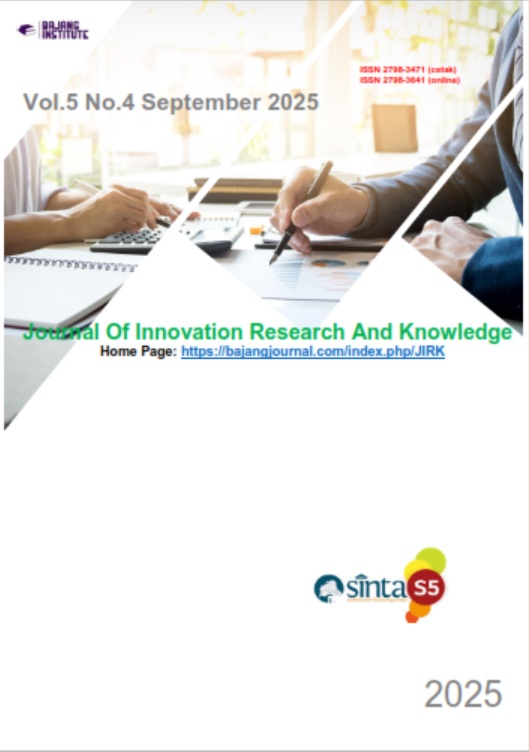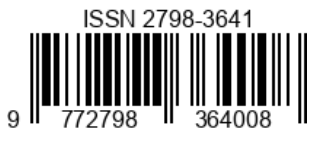ANALYSIS OF THE LINGUISTIC LANDSCAPE OF NAKULA STREET SIGN IN SEMINYAK, BALI
DOI:
https://doi.org/10.53625/jirk.v5i4.11229Keywords:
Linguistic Landscape, Signage, Multilingualism, Language UseAbstract
This study analyzes the use of language on signs along Nakula Street in Seminyak, Bali, an area known as an international tourist destination. The purpose of this study is to identify the dominant language types used on the signs and to analyze the creative linguistic devices employed to attract attention. Data from 118 signs were collected through virtual documentation using Google Maps Street View. The results show that the majority of the signs (66.95%) are monolingual, with English being the most dominant language (50.83%). Bilingual signs (32.20%) often combine Indonesian and English. In addition, various linguistic devices such as code-mixing, transliteration, and slang were also found. These language choices reflect business owners' strategies to communicate with international tourists while maintaining local cultural identity. This study provides a deeper understanding of how language in public spaces can reflect identity, culture, and commercial goals in a multicultural tourism environment
References
Agustini Putri, P. D. (2022). Politeness Strategies Used in the First Trump-Clinton Presidential Debate. International Journal of Language and Literature, 6(1), 35–43. https://doi.org/10.23887/ijll.v6i1.46491
Artawa, K., Mulyanah, A., Atmawati, D., Paramarta, I. M. S., Satyawati, M. S., & Purnawati, K. W. (2023). Language Choice and Multilingualism on Restaurant Signs: A Linguistic Landscape Analysis. International Journal of Society, Culture and Language, 11(3), 258–271. https://doi.org/10.22034/ijscl.2023.2007382.3106
Budiarsa, M., & Kristianto, Y. (2018). Linguistic Capital as Foreign Domination Structure in Tourism Domain: a Case Study in Seminyak Bali. Udayana Journal of Social Sciences and Humanities (UJoSSH), 2(2), 97. https://doi.org/10.24843/ujossh.2018.v02.i02.p05
Christison, M. (2018). Speech Act Theory and Teaching Speaking. In The TESOL Encyclopedia of English Language Teaching (pp. 1–6). Wiley. https://doi.org/10.1002/9781118784235.eelt0712
Dewi Merlyna Yuda Pramesti, P., & Satya Hermawan, G. (2024). PROCEEDING OF SEMINAR NASIONAL RISET LINGUISTIK DAN PENGAJARAN BAHASA (SENARILIP VIII) 11 th of September 2024 | https://ojs2.pnb.ac.id/index.php/SENARILIP/ Analysis of the Linguistic Landscape of Signboards in Japan (A Semiotic Study). September, 12–24. https://ojs2.pnb.ac.id/index.php/SENARILIP/
Erawati, N. K. R., Mulyawan, I. W., & Sulibralyi, I. K. N. (2023). Balinese transliteration in public space: Error analysis in linguistics landscapes. Forum for Linguistic Studies, 5(2). https://doi.org/10.59400/fls.v5i2.1788
Gorter, D., & Cenoz, J. (2015). Linguistic Landscape and Multilingualism. In Language Awareness and Multilingualism (pp. 1–13). Springer International Publishing. https://doi.org/10.1007/978-3-319-02325-0_27-1
Jolayemi1, D., & Memunat, M. (2017). ROAD SIGNS AS LINGUISTIC LANDSCAPE IN NIGERIA: A SEMIOTIC COMMUNICATION Demola. International Journal of English Language and Linguistics Research, 5(5), 1–14. http://www.albayan.ae
Krasnowska-Kieraś, K., & Woliński, M. (2023). Constituency Parsing with Spines and Attachments. In Lecture Notes in Computer Science (including subseries Lecture Notes in Artificial Intelligence and Lecture Notes in Bioinformatics): Vol. 14073 LNCS (pp. 191–205). https://doi.org/10.1007/978-3-031-35995-8_14
Liu, J., & Wiener, S. (2020). Homophones facilitate lexical development in a second language. System, 91, 102249. https://doi.org/10.1016/j.system.2020.102249
Prihartini, N. D. (2023). LINGUISTIC LANDSCAPE ANALYSIS ON COFFEE SHOP SIGNBOARD IN KOTA PROBOLINGGO (Issue Ll). http://repository.upm.ac.id/id/eprint/4306
Purnawati, K. W., Artawa, K., & Satyawati, M. S. (2022). Linguistic Landscape of Jalan Gajah Mada Heritage Area in Denpasar City. Jurnal Arbitrer, 9(1), 27–38. https://doi.org/10.25077/ar.9.1.27-38.2022
Renner, V. (2015a). Lexical blending as wordplay. Wordplay and Metalinguistic /Metadiscursive Reflection: Authors, Contexts, Techniques, and Meta-Reflection, 119–133. https://doi.org/10.1515/9783110406719-006
Renner, V. (2015b). Lexical Blending as Wordplay. In Wordplay and Metalinguistic / Metadiscursive Reflection (pp. 119–134). DE GRUYTER. https://doi.org/10.1515/9783110406719-006
Setyawan, A. H., Mercu, U., Yogyakarta, B., Rahmawan, A. D., & Yuniarto, H. (2024). A LINGUISTICS LANDSCAPE STUDY ON. 8, 155–173. https://doi.org/https://doi.org/10.31539/leea.v8i1.13428
Stone, L. (2021). Spelling for Life. In Etika Jurnalisme Pada Koran Kuning : Sebuah Studi Mengenai Koran Lampu Hijau (Vol. 16, Issue 2). Routledge. https://doi.org/10.4324/9781003125686
Umi Kulsum. (2023). Abbreviation in Indonesian Language. Proceeding of International Seminar Enrichment of Career by Knowledge of Language and Literature, 11(1), 1–11. https://doi.org/10.25139/eckll.v11i1.7694
Van Mensel, L., Vandenbroucke, M., & Blackwood, R. (2016). Oxford handbook of language and society. Linguistic Landscapes. Oxford Handbook of Language and Society, 423–449.
Vitasari, B. N., & Setyawan, A. H. (2025). Linguistic Landscape Study of Culinary Signage on Palagan Street, Yogyakarta. 19(1), 146–157. https://doi.org/https://doi.org/10.24843/e-jl.2025.v19.i01.p13
Zahra, S. T., Setia, E., & Zein, T. (2021). Linguistic landscape on coffee shop signboards in Medan. Budapest International Research and Critics Institute-Journal (BIRCI-Journal), 4(3), 5445–5457.













